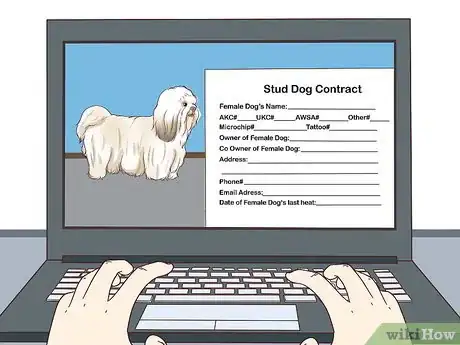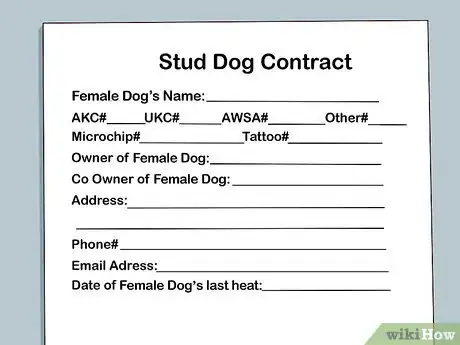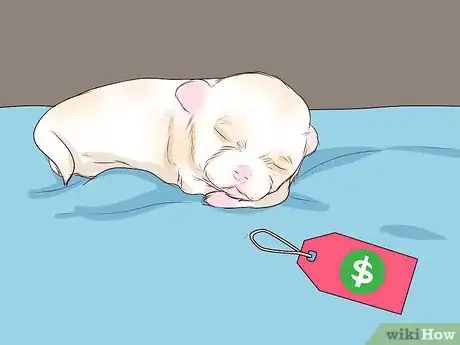This article was co-authored by Pippa Elliott, MRCVS. Dr. Elliott, BVMS, MRCVS is a veterinarian with over 30 years of experience in veterinary surgery and companion animal practice. She graduated from the University of Glasgow in 1987 with a degree in veterinary medicine and surgery. She has worked at the same animal clinic in her hometown for over 20 years.
There are 8 references cited in this article, which can be found at the bottom of the page.
wikiHow marks an article as reader-approved once it receives enough positive feedback. In this case, 94% of readers who voted found the article helpful, earning it our reader-approved status.
This article has been viewed 109,054 times.
Before you decide to breed Shih Tzus, consider the time, effort, and expenses required to take on the project. Good breeders are not motivated by profit, but by a desire to better the breed. Make sure that both the female and male are healthy and have been screened for genetic disorders. Facilitate breeding encounters for the two dogs, and monitor your female closely in the weeks following. Prepare a birthing space, and make sure to be present during the delivery of the puppies to assist your Shih Tzu if anything goes wrong. Be prepared to care for the puppies until you sell them to a good home.
Steps
Knowing What to Expect
-
1Speak to an experienced breeder. The best way to find out what you’re in for if you breed Shih Tzus is to interview an experienced Shih Tzu breeder, or another Shih Tzu expert. Breeders can tell you firsthand what to expect from the experience, what troubles might arise, and what mistakes you should avoid. The American Shih Tzu Club has several breeder referral volunteers who can be contacted for advice about the breed as well as contact information for Shih Tzu breeders.
-
2Make sure you can commit the time to breeding. Raising an average litter requires at least 130 hours of a breeder’s time, and may require days off work and sleepless nights. Make sure that you are ready to commit the time and personal effort required to care for both puppies and their mother throughout the process of breeding; remember that a mother can’t be left alone during the process of whelping (i.e. giving birth), and that newborn puppies require daily care and checking. Feeding and socializing the puppies, cleaning, paperwork, and interviewing buyers will all require long periods of your time as well.Advertisement
-
3Budget properly. Before going into dog breeding, you should know that it is not a money-making endeavor. Good breeders prioritize the good of the breed and the welfare of their puppies over profit - as such, the process may not offer a large return. Costs include food, health care and vaccinations, facilities, documents for proof of quality, advertising, and stud fees (if applicable).
-
4Be prepared for the worst. First time breeders don’t have established reputations or references and run the risk of not selling their puppies. Ask yourself what you will do if your puppies don’t sell, and if you are willing to care for them on a long-term basis if they don’t. While unscrupulous breeders often get rid of puppies that don’t sell, or sell them to laboratories or other undesirable buyers, good breeders will accept the liability. You should also be prepared, financially and mentally, for the possibility of having unhealthy puppies in your litter.
Facilitating the Breeding Process
-
1Make sure that both Shih Tzus are healthy. You must make sure that both the female (dam) and male (sire) are healthy and genetically fit for breeding, and that their vaccinations are current. Testing should be done for conditions that the Shih Tzu breed is prone to, such as heritable eye diseases, Hip Dysplasia, Renal Dysplasia, thyroid disorders, and hearing loss. Once a dog is cleared of one of these conditions, it can be registered with the appropriate registry (e.g. once a dog is tested and cleared of heritable eye diseases, it can be registered with the the local Canine Eye Registry).[1] >
- The female Shih Tzu should get a thorough pre-breeding physical examination by a veterinarian about a month before breeding begins.[2]
-
2Make sure your female Shih Tzu is ready for breeding. Ideally, your Shih Tzu should have her first litter after her second heat cycle but before she's reached the age of 4. Because of health risks, dogs older than 7 should not be bred. Female Shih Tzus stay in heat (i.e. the period in a dog’s reproductive cycle when she is receptive to mating) for approximately 16 days, but are usually not receptive to males on the first day of this period.[3]
- If a female is not ready to mate, she will run from or avoid a male; if she is ready, she will stay and move her tail to the side to signal her readiness.
-
3Choose the right stud. Put up flyers, take out a classified ad, or look online for possible studs. Remember that, as a general rule, a male should be smaller than the female Shih Tzu it breeds with by a pound or two. It should also complement your female Shih Tzu in terms of attributes and qualities, and offer genetic strengths that will result in strong, quality offspring (e.g. a good coat).[4]
-
4Work out a stud contract. Before breeding occurs, you should work out a contract with the stud's owner outlining obligations, fees, and payment. Stud fees can run between $250-$1000, depending on the quality of the male. but some contracts will outline other forms of payment to the stud's owner (e.g. the pick of the litter in lieu of cash payment). Both parties should sign and keep a copy of the contract.[5]
-
5Pair the Shih Tzus. Given that females are more comfortable in new environments than males, you should bring the female to the stud, and not vice versa. Depending on the details of your agreement with the stud's owner, you can either go back for breeding visits as scheduled, or leave the female in the custody of the stud owner during the breeding period. Make sure that all such terms are outlined before the process begins.[6]
-
6Confirm the female's pregnancy. The average gestation time for a Shih Tzu is between 59 to 65 days from the date of breeding. While signs of pregnancy may be misleading (e.g. increased appetite, weight gain), a veterinarian can confirm pregnancy around day 28. The veterinarian can also advise you about how to care for and feed your pregnant Shih Tzu.[7]
-
7Prepare for the whelping. Prepare for the birth of the puppies by making a whelping box (i.e. a place for your Shih Tzu to give birth). This could be a cardboard box with low edges, a wooden box, or any other box that is wide enough to accommodate the female and the puppies, once they are born. Introduce the whelping box early enough for your Shih Tzu to get used to it before giving birth; line it with towels to make it more comfortable.[8]
Taking Care of the Shih Tzus
-
1Monitor the birth. Approximately 24 hours before whelping, the female's temperature will drop. As the time to give birth approaches, she will begin to demonstrate more signs of discomfort (panting, seeming restless). For Shih Tzus, whelping generally lasts 3-8 hours, depending on the number of puppies and the strength of contractions.[9] Dogs are generally able to give birth without assistance, but you should be present to do the following (when, and if, needed):[10]
- Removing the placental membrane or cutting the umbilical cord in the event that the mother does not do it on her own
- Count the placentas delivered to make sure that no placentas have been retained
- Call the veterinarian in the event of an emergency (e.g. two hours or more between delivery of puppies in the litter, a common issue for small dogs like Shih Tzus)
-
2Look after the puppies. Puppies should be weighed every day to make sure they're growing, and that they are healthy. Make sure that all puppies are nursing properly, and that they're kept warm; a heating pad or heating lamp can be used, if necessary. Once puppies are weaned from their mother, they will need to be fed; at this point, it is wise to start socializing the puppies to improve their temperament and get them accustomed to canine and human interactions.
-
3Take care of the dam. After giving birth, the female will require some extra attention. After whelping, she will need three to four times more food than her regular diet in order to nourish her puppies. Be sure that she consumes calcium, phosphorous, and vitamin D to avoid eclampsia.[11]
Selling Your Puppies
-
1Register the litter. Register your litter with the American Kennel Club shortly after whelping. This will demonstrate to potential buyers that you're a responsible breeder, and it will establish each individual puppy as an important part of the betterment of their breed. New owners of these puppies will have access to the group's events, services, and information.[12]
-
2Establish your price range. The price of Shih Tzu puppies can range tremendously, so you should set a price for yours and stick to it. Prices is based on whether or not the puppies have already been vaccinated, the prices of other local breeders, and your reputation as a breeder. Being consistent about your prices will give you credibility as a serious breeder.[13]
-
3Find good homes for your puppies. You should put a lot of thought and effort into choosing new owners for your Shih Tzu puppies, and make sure that potential owners are making the right choice for their lifestyles. Shih Tzus are excellent companion dogs who do not require a lot of exercise, but require daily grooming; if buyers are looking for a more playful and energetic breed, or if you simply do not think a Shih Tzu is what they want, do not sell to them. Good breeders are responsible for the well-being of their puppies long after they are sold.[14]
References
- ↑ http://www.allshihtzu.com/breeding-a-shih-tzu
- ↑ http://www.akc.org/dog-breeders/responsible-breeding/#litter
- ↑ http://www.allshihtzu.com/breeding-a-shih-tzu
- ↑ http://www.akc.org/dog-breeders/responsible-breeding/#litter
- ↑ http://dogs.lovetoknow.com/wiki/Dog_Stud_Service
- ↑ http://dogs.lovetoknow.com/wiki/Dog_Stud_Service
- ↑ http://www.akc.org/dog-breeders/responsible-breeding/#litter
- ↑ http://totallyshihtzu.com/want-to-breed-your-shih-tzu-think-about-it-first/
- ↑ https://pethelpful.com/dogs/How-to-Take-Care-of-Your-Pregnant-Dog
- ↑ http://www.akc.org/dog-breeders/responsible-breeding/#litter
- ↑ http://www.akc.org/dog-breeders/responsible-breeding/#litter
- ↑ http://www.akc.org/register/?pre=breeder&activity=litter
- ↑ http://www.allshihtzu.com/cost-of-shih-tzu
- ↑ https://www.ckc.ca/en/Choosing-a-Dog/Choosing-a-Breed/Non-Sporting-Dogs/Shih-Tzu
About This Article
Before breeding your Shih Tzus, have them checked out by your vet to ensure they're both healthy and fit for breeding. If you only own the female dog, work out a stud contract with the male dog's owner outlining the obligations, fees, and payment. Then, leave the dogs together for the entire time the female in in heat, which will be about 16 days. Finally, wait 28 days before bringing the female to a veterinarian so that you can confirm the pregnancy. For advice from our Veterinary reviewer on how to prepare a whelping box for your Shih Tzu to give birth in, keep reading.














































































